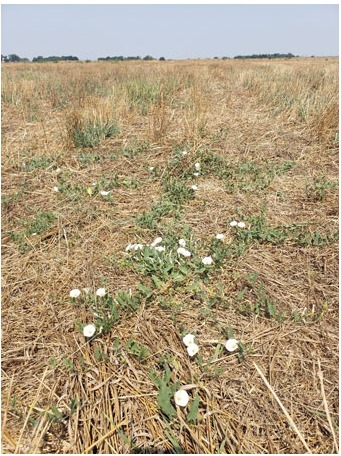Pre-emergence herbicides with residual activity are an important component of high-yielding cropping systems. They are used less frequently in wheat production compared to other cropping systems in Kansas, but residual herbicides applied prior to wheat emergence can be part of a good weed management system in wheat production. Selected products for this use are described in Table 1.
Most residual herbicides labeled for pre-emergence application in wheat are Group 2 (ALS-inhibiting) herbicides, which are associated with herbicide resistant populations of kochia, marestail (horseweed), bushy wallflower, flixweed, henbit, and brome species in Kansas. Products in Groups 14 (the PPO-inhibiting herbicides) and 15 (the long-chain fatty acid inhibiting herbicides) are also labeled; however, they are generally more dependent on rainfall for activation than the Group 2 herbicides.
Herbicides without residual activity may be applied with or without residual herbicides in the weeks prior to planting wheat. Older products include the Group 2 herbicides Amber, Olympus, and Pre-Pare, as well as Group 4 (plant growth regulating) herbicides like 2,4-D, dicamba, or fluroxypyr. It is especially important to be aware of planting interval restrictions for Group 4 herbicides, which range from 10 to 45 days.
When selecting pre-emergence herbicides for use in wheat production, keep in mind that many of these products are also labeled for use in emerged wheat. Unless using a planned split-application, avoid repeated use of products from the same herbicide group to slow the development of herbicide-resistant weed populations in your fields.
Table 1. Select herbicides for pre-emergence or pre-plant applications in winter wheat.
Trade name | Common name | Herbicide group | Application timing* | Comments |
Amber | Triasulfuron | 2 | BD, PRE or POST | Requires tank mix or sequential application of herbicide from different group |
Anthem Flex | Pyroxafulfone + carfentrazone | 15 + 14 | DPRE | Plant wheat 1 – 1.5” deep |
several | Dicamba | 4 | BD | Apply at least 45 days before planting wheat |
Facet | Quinclorac | 4 | BD | Plant wheat at least 1” deep |
Finesse | Chlorsulfuron + metsulfuron | 2 + 2 | PRE, POST | Suppression only of cheat, downy brome, and Japanese brome |
Kochiavore | Fluroxypyr + bromoxynil | 4 + 6 | BD | Apply at least 30 days before planting wheat |
Olympus | Propoxycarbazone | 2 | PRE, POST | Mix with glyphosate for BD |
Outrider | Sulfosulfuron | 2 | PRE, POST | Apply after planting but before wheat emergence;
If dry, apply POST |
Pixxaro | Fluroxypyr + halauxifen | 4 + 4 | BD, POST | Do not use multiple applications or in successive years at the same site |
Pre-Pare | Flucarbazone | 2 | BD, PRE | Mix with glyphosate for BD;
Rainfall necessary for activation to control PRE |
Scorch | Fluroxypyr + dicamba | 4 + 4 | BD | Apply at least 30 days before planting wheat |
Sharpen | Saflufenacil | 14 | BD, PRE | Rainfall required for activation;
Injury may occur to exposed wheat seed |
Zidua | Pyroxasulfone | 15 | DPRE | Rainfall required for activation; Plant wheat 1 – 1.5” deep |
several | 2,4-D | 4 | PRE, POST | Apply at least 2 weeks after a 0.5” rainfall before planting wheat |
*BD = burndown; PRE = preemergence to wheat and weeds; DPRE = Delayed preemergence application after wheat emergence; POST = postemergence
Field bindweed control
Field bindweed (Figure 1) is a particularly troublesome weed for which a special discussion is justified. In a 12-year experiment conducted at the Agricultural Research Center in Hays, field bindweed reduced wheat yield 2 to 50%. Management of this weed during wheat establishment is important because field bindweed continues to grow until temperatures drop below 20°F.
The herbicides most commonly recommended for field bindweed control include various formulations of 2,4-D, dicamba, and glyphosate. Dicamba tends to provide greater control for fall applications compared to 2,4-D or glyphosate, especially if plants are drought-stressed. Another commonly used product is Facet (quinclorac). It is most effective when applied just before the first killing frost. Other herbicides that are labeled for fall application to control or suppress field bindweed in wheat include Affinity, Aim, and Cimarron.
Satisfactory control of field bindweed will not be achieved with a single herbicide application. It will take multiple years of herbicide applications to deplete the energy stored in the root system and control an established infestation.
 c
c
Figure 1. Field bindweed growing in a harvested wheat field. Photo by Sarah Lancaster, K-State Research and Extension.
Source : ksu.edu